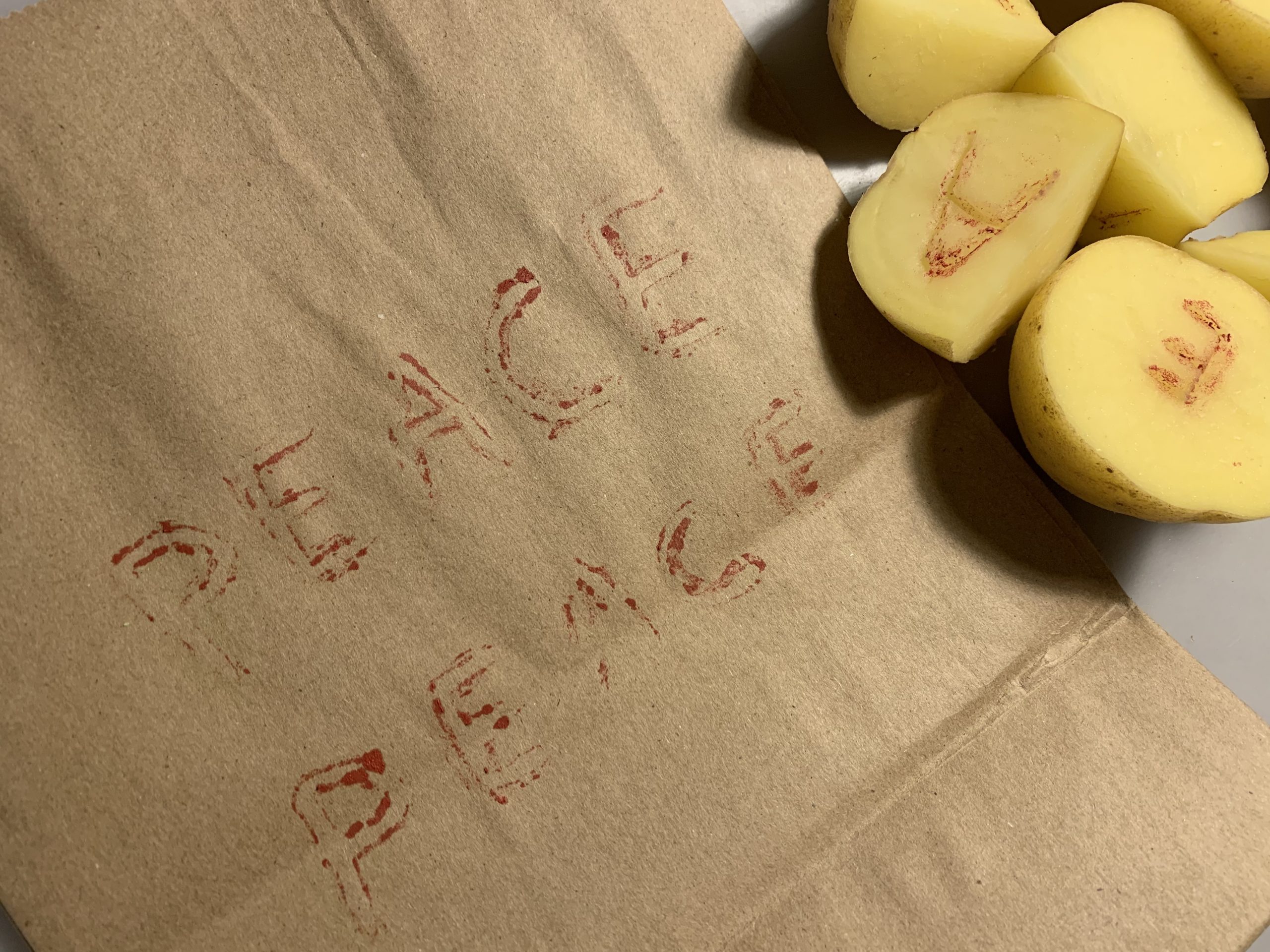
To create this print, I used whatever items I could find at home:
- knives
- potatoes
- paper bag
- pens
- markers
- lipstick
- eyeshadow brush
I have to admit, this is a really interesting project. That is why I enjoyed it so much without even noticing the time. In total, I used 25 minutes to craft this potato challenge. There were two sets of 5 letters “PEACE” being carved on potatoes. I wish they would look more alike, in fact, they do not look identical at all. Anyone who has attempted to carve letters on a potato might find it hard to create identical letters. Perhaps Paul Collier would agree too, who works as a Letterpress and Typography technician at the University of Plymouth. He says one of the key steps is to create these pre-molded and reusable letters (Cooke, 2012). In my project, you can hardly see print consistency in those handwritten letters. And I think that’s also one of the reasons why this assignment exists, in other words, to prove mechanization in many ways has made knowledge more accessible and producible.
The project was somehow therapeutical which I enjoyed, meanwhile, it was also a very time-consuming process. I took some time to figure out the print letters are actually upside down and follow the order from left to right. Who would know this before? The most challenging part for me is inking. I tried markers and pens which ended up in vain, I went in and out of the room multiple times to find the best tool. Gladly, my lipstick and eye shadow brush didn’t fail me. From now on, I will be proud of my potato-smelled lipstick and brush.
I figure it must be a tricky task for our forefathers. The origin of ink can be dated back to 4500 years ago in Egypt and China when people used charcoal and animal fat as the main ingredients of making ink (Noissue, 2018). It might seem foreign to us today but it was an important invention in the early years. Many of us were born in this era with books to read, newspapers, magazines, and other printed matters like brochures, flyers, posters, and etc. This wouldn’t be true without mechanization, especially after the Industrial Revolution when people witnessed a huge leap in printing production (Bolter, 2001). Therefore I find it fascinating that our ancestors used parchment, scroll, and papyrus to bear the written language, so it could be preserved and passed on to the next generation. Some have been discovered by historians and archaeologists, so we could gather a glimpse of what the past looked like. For instance, the four surviving Maya Codices (Heather, 2004).
References
Bolter, Jay David. (2001). Writing space: Computers, hypertext, and the remediation of print [2nd edition]. Mahwah, NJ: Lawrence Erlbaum.
Danny, Cooke. (2012). Upside Down, Left to Right: A Letterpress Film (YouTube video). Retrieved from here.
Noissue. (2018). The History of Ink: beyond the box. Retrieved from here.
McKillop, Heather. (2004). The Ancient Maya: New Perspectives. New York: Norton.
ChristinaHidalgo
October 10, 2021 — 11:47 am
Hi Vera,
What an interesting process, and I can only imagine the frustration of not finding the right tools right away, the trial and error, and finally the pride in accomplishing your task! Your connection to the efforts of ancient people who would go through such effort to pass down knowledge, stories or history onto the next generation really made me stop and think. As you state, I am one who grew up when literacies are plentiful and extremely easy to both create and obtain. How much more meaning would be in the words if it took authors as much time as it did you?